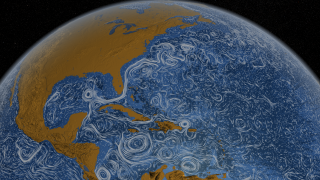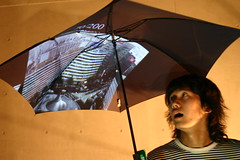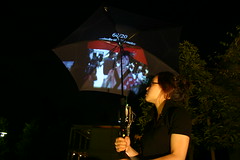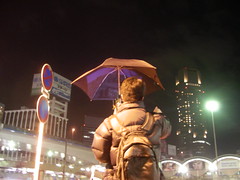

A supercut of inhalations and exhalations from (in order) Willem de Kooning, Barnett Newman, Robert Motherwell, Robert Rauschenberg, Kenneth Noland, Jasper Johns & Larry Poons.
From "Painters Painting", the original 1972 film by Emile de Antonio, and inspired by the current exhibition at Atlanta Contemporary Art Center, "Paintings Panting".
http://thecontemporary.org/exhibitions/painters-panting/
http://michaeldavidmurphy.com
YubNub is a command-line for the web. After setting it up on your browser, you simply type "gim porsche 911" to do a Google Image Search for pictures of Porsche 911 sports cars. Type "random 49" to return random numbers between 1 and 49, courtesy of random.org. And best of all, you can make a new command by giving YubNub an appropriate URL.
Gifsicle is a command-line tool for creating, editing, and getting information about GIF images and animations. Making a GIF animation with gifsicle is easy:
gifsicle --delay=10 --loop *.gif > anim.gif
Extracting framesfrom animations is easy too:
gifsicle anim.gif '#0' > firstframe.gif
You can also editanimations by replacing, deleting, or inserting frames:
gifsicle -b anim.gif --replace '#0' new.gif
Some more gifsicle features:
Two other programs are included with gifsicle: gifview is a lightweight animated-GIF viewer which can show animations as slideshows or in real time, and gifdiff compares two GIFs for identical visual appearance.
Manuel français : http://www.traduction.cc/traduction/Manuel-Gifsicle-12.html
How do Adobe Photoshop, Micrografx PicturePublisher and Pegtop XFader blend layers?
This article tries to give a survey of the most important blend modes, their advantages and disadvantages, and how they are coded.
Recursive Drawing is an exploration of user interface ideas towards the development of a spatially-oriented programming environment.
Recursive Drawing is by Toby Schachman for his ITP thesis project Alternative Programming Interfaces for Alternative Programmers.
Panorama d'exposition net art en ligne
Touché proposes a novel Swept Frequency Capacitive Sensing technique that can not only detect a touch event, but also recognize complex configurations of the human hands and body. Such contextual information significantly enhances touch interaction in a broad range of applications, from conventional touchscreens to unique contexts and materials. For example, in our explorations we add touch and gesture sensitivity to the human body and liquids. We demonstrate the rich capabilities of Touché with five example setups from different application domains and conduct experimental studies that show gesture classification accuracies of 99% are achievable with our technology.
0-DAY (pronounced as zero day) - refers to any ART - Works produced through the expression or copy of work that has been released the same day application of human creative skill and as the original, or sometimes even before. It is imagination, typically in a visual form such as considered a mark of skill among warez distro GIFs or HTML, producing works to be appreciated groups to crack and distribute a program on the primarily for their beauty or emotional power. same day of its commercial release.
Souvenirs from Earth is the first Cable TV station broadcasting a 24/7 program of Video art, Film, Visual art, Music, Installations and Performances, transforming bigger flat screens into an art terminal, giving access to the avant-garde of visual cultures. We give art more visibility and create new opportunities for art professionals, investigating the ever changing position of art in contemporary culture.
EyesWeb is an open software research platform for the design and development of real-time multimodal systems and interfaces.
Entretien avec le philosophe Bernard Stiegler, réalisé lors du tournage du documentaire "Après la Gauche".
Documentaire réalisé par Jérémy Forni et écrit par Jérémy Forni, Geoffroy Fauquier et Gaël Bizien.
Association citée par B. Stiegler : http://arsindustrialis.org/
Émission du 15 janvier 2012, avec Mériol Lehmann, artiste en art audio de Québec et directeur général et de production au centre Avatar
http://mlehmann.ca/
This visualization shows ocean surface currents around the world during the period from June 2005 through Decmeber 2007. The visualization does not include a narration or annotations; the goal was to use ocean flow data to create a simple, visceral experience.

The Social Collider reveals cross-connections between conversations on Twitter.
With the Internet's promise of instant and absolute connectedness, two things appear to be curiously underrepresented: both temporal and lateral perspective of our data-trails. Yet, the amount of data we are constantly producing provides a whole world of contexts, many of which can reveal astonishing relationships if only looked at through time.
This experiment explores these possibilities by starting with messages on the microblogging-platform Twitter. One can search for usernames or topics, which are tracked through time and visualized much like the way a particle collider draws pictures of subatomic matter. Posts that didn't resonate with anyone just connect to the next item in the stream. The ones that did, however, spin off and horizontally link to users or topics who relate to them, either directly or in terms of their content.
The Social Collider acts as a metaphorical instrument which can be used to make visible how memes get created and how they propagate. Ideally, it might catch the Zeitgeist at work.
Retouches features a series of repeated visual cycles, an animation painted on celluloid that examines transformation in the world around us.
As with 78 tours and Jeu, Georges Schwizgebel tries to grasp the ungraspable -- movement itself -- by playing with notions of perception and representation, changing the balance of shapes for amazing metamorphoses. He turns someone going upstairs into a hurdler and hair being brushed into a windswept forest; as for a tennis game, the ball remains motionless and the court whirls spectacularly around it.
Finally the film calms down into an image of a sleeping woman perhaps dreaming of the very images we ourselves have just observed. Retouches is the virtuoso dream of a visual acrobat.
#000000;">Imagine a kung fu flick in which the martial artists spout Situationist aphorisms about conquering alienation while decadent bureaucrats ply the ironies of a stalled revolution. This is what you’ll encounter in René Viénet’s’s outrageous refashioning of a Chinese fisticuff film. An influential Situationist, Viénet’s stripped the soundtrack from a run-of-the-mill Hong Kong export and lathered on his own devastating dialogue. . . . A brilliant, acerbic and riotous critique of the failure of socialism in which the martial artists counter ideological blows with theoretical thrusts from Debord, Reich and others. . . . Viénet’s’s target is also the mechanism of cinema and how it serves ideology.
http://www.ubu.com/film/vienet_dialectics.html
New research reveals why people like to reread books, re-watch movies and generally repeat the same experiences over and over again. It’s not addictive or ritualistic behavior, but rather a conscious effort to probe deeper layers of significance in the revisited material, while also reflecting on one's own growth through the lens of the familiar book, movie or place.
Bret Victor invents tools that enable people to understand and create. He has designed experimental UI concepts at Apple, interactive data graphics for Al Gore, and musical instruments at Alesis.
For more on Bret, see worrydream.com.
This talk was given at CUSEC 2012 (2012.cusec.net).
Pileus is an umbrella connected to the Internet to make walking in rainy days fun. Pileus has a large screen on the top surface, a built-in camera, a motion sensor, GPS, and a digital compass. The current prototype has two main functions: photo-sharing and 3D map navigation.
The photo function is connected to a major web service: Flickr API. A user can take photo with a camera on the umbrella, and pictures are uploaded to Flickr in two minutes with context tags via a wireless Internet connection. User can also enjoy theirselves watching photo-streams downloaded from Flickr with simple operation of wrist snapping.


It also has a function of 3D Map. Detecting a location data from GPS, it shows a 3D bird view around the user. User can walk-through a city comparing the 3D views and real sights, and the map is always updated by GPS and a digital compass. It aims to create natural augmented reality with a large informatin screen on the umbrella.

These two functions can be switched by simply fliping a switch. As a future direction of its development, putting a context data on the Internet (e.g. geo-tags on photos), it will be able to provide social local-navigations and real-time in-place communications. The product aims to provide an augmentation of everyday life synchronizing information on the Internet and the real place.
The EUscreen project aims to promote the use of television content to explore Europe's rich and diverse cultural history. It will create access to over 30,000 items of programme content and information, and by developing a number of interactive functionalities and dynamic links with Europeana it will prove valuable to the widest range of cultural, educational and recreational users.
FRACT is a first person adventure game for Windows & Mac much in the vein of the Myst titles, but with an electro twist. Gameplay boils down to three core activities: Explore, Rebuild, Create. The player is let loose into an abstract world built on sound and structures inspired by electronic music.
It’s left to the player to explore the environment to find clues to resurrect and revive the long-forgotten machinery of this musical world, in order to unlock its’ inner workings.
The sound devices described below were used for the first time by Echelle Inconnue in September 2010 in "plan d'Aou", a district of Marseilles, France, within the framework of the Smala project in order to trace a sound cartography of Islam in the city of Marseilles.
About fifteen sound edits were geolocalized in the district, these mobile prototypes gave the possibility to each one to listen to them while walking across "plane d'Aou" (For more information read (in french) : Smala Marseille, or listen online to the sounds edits)
Several cases were imagined for a sound diffusion at the level of the district of "plan d'Aou", and our choice was made on a geolocalized sound system which makes "the walls whisper" by allowing a collective listening, located on places or selected spaces. This solution appeared the most appropriate to the context of the project and the district.
Conservators at the Prado in Madrid recently made an astonishing discovery. They announced yesterday that the painting assumed to be a replica of the Mona Lisa, had actually been painted by one of his key pupils, working alongside the master. The picture is more than just a studio copy – it changed as Leonardo developed his original composition.
The so-called “Mona Lisa of the Prado” has long been in the museum’s collection, tucked away in its vaults and displayed only occasionally, its significance not fully understood. The experts thought it was painted by some Dutch artist because they assumed it was painted on oak (a wood not used by Florentine painters), but actually it was painted on walnut. In size, it is close to that of the original: the Louvre’s painting is 77cm x 53cm and the Prado’s copy 76cm x 57cm.
Visualization of the market place, by size and colors
Drag this bookmarklet to your bookmarks bar.
You need Firefox or Chrome to use goggles.
Activate on any webpage.
Draw with the left mouse button.Erase with the right mouse button.
After his older brother Victor died in Berlin, Cristian (17) decides to make a documentary about his family and his brother's best friends. How do they feel? How do they deal with the death of someone so close to them?
Inspired by the home videos I made since the late eighties, in this, my first feature film and/or mockumentary, I 'kill' myself to interview my family and my best friends from Chile and Germany, exploring the acting skills of non actors and the line between fiction and documentary.
United Arab Emirates billionaire Sheikh Hamad Bin Hamdan Al Nahyan has etched his name in the sand on Al Futaysi island in Abu Dhabi in such big letters it can be seen from space.
A satellite image from space confirms the enormous letters of the name “HAMAD” carved into the sand on Al Futaisi Island in Abu Dhabi. The name stretches a staggering two miles long and will likely be a permanent fixture on the distant island.
The island of Futaisi lies near the barrier island of Bahrani, in a shallow sheltered lagoon-type complex to the southwest of Abu Dhabi Island.
Billionaire Sheikh Carves Name Hamad in Sand; Visible From Space
Rapid Prototyping, otherwise known as 3D printing.
More here : 3D printing for architects
pocode is an open-source C++ library designed by Potion for the production of interactive media across multiple platforms. pocode provides a robust, high-performance software infrastructure that allows for the creation of all types of software, from simple visual sketches to elegant mobile apps to entire software applications.
At the center of pocode’s design is a desire to make an all-purpose software library that is as simple to use as it is efficient and powerful. Thanks to pocode’s object-oriented architecture, applications stay organized and take care of themselves. Objects draw themselves, maintain their state and can be changed at any time. pocoders don’t have to worry about the intricacies of event routing, the details of threaded image loading or the pitfalls of shader construction. All of these processes are handled automatically.
At the same time, pocode is an open system that allows pocoders to dive deep into the software architecture and implement alternative methods of their own. Because of pocode’s modular design, this kind of tinkering and re-engineering can place without altering the library itself. pocoders can also extend pocode with their own poObjects, and share them with other pocoders. Since all poObjects fit within pocode’s object-oriented framework, shared poObjects can easily be incorporated into new applications, even across platforms.
While we have designed pocode with great intentionality, we see it as a work in progress. pocode is an evolving platform that will change over time in response to user feedback and to new technologies. Simply put, we want pocode to be the simplest, most useful and most technically sound software library available anywhere for the creation of interactive media.


A visualization of money by size by Xkcd
Kiwix is an offline reader for Web content. It's especially intended to make Wikipedia available offline (see features). This is done by reading the content of the project stored in a file format ZIM, a high compressed open format with additional meta-data.
The digital revolution of the last decade has unleashed creativity and talent in an unprecedented way, with unlimited opportunities.
But does democratized culture mean better art or is true talent instead drowned out? This is the question addressed by PressPausePlay, a documentary film containing interviews with some of the world's most influential creators of the digital era. presspauseplay.com @presspauseplay Facebook: on.fb.me/y4gEK1
AccuJazz is an all-Jazz radio station designed to showcase the exciting potential of Internet radio. It contains over fifty jazz channels based on categories of style, instrument, composer, region, decade and more. Each channel is further customizable by the option to "deselect" artists the listener would rather not hear. New subchannels are added frequently. The variety of channels and their customizable nature makes AccuJazz a radio experience unlike any other.

This audio reading of The Metamorphosis is read by David Barnes. Contents : # I - 00:49:52 # II - 00:53:51 # III - 00:50:42
Mobile is a French-American bilingual magazine, where a part of creation meets a part of reflection.